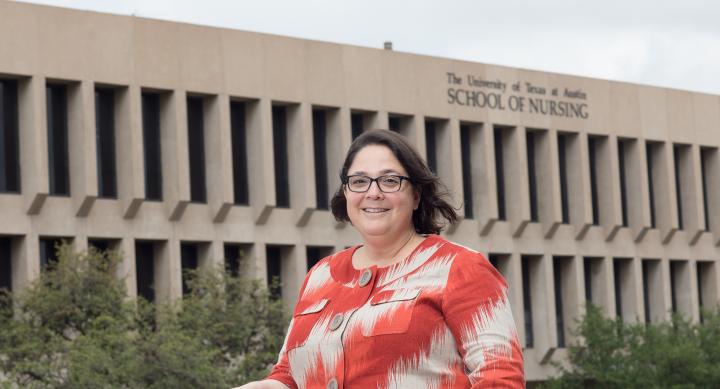
The good news is that people living with human immunodeficiency virus (HIV) and who are in routine care are living longer and healthier lives. The bad news is that because the virus puts them at risk for other diseases, such as heart disease and type 2 diabetes, this improvement may not be the end of the story. Even worse news, many people living with HIV (PLWH) are often unaware of this increased risk and go untreated.
Part of the problem is that some HIV medications make it harder for the body to use insulin, which can result in type 2 diabetes. Age, lack of exercise and family background and history also raise the risk of developing diabetes.
Julie Zuñiga, PhD, RN, and assistant professor at the School of Nursing, hopes to pinpoint the causes behind a progression to diabetes and improve health outcomes for this population. Her research focuses on self-management of stigmatized illnesses in conjunction with co-morbid conditions, with a focus on HIV and diabetes.
“One of the reasons that PLWH may develop chronic diseases is good: They are living longer. But HIV is hard on the body, and lowlevels of chronic inflammation associated with it puts one at risk for heart disease and kidney failure, just to name a few,” Zuniga said. “If they get tested and connected to regular care — at least two to four times a year — and keep taking their medication to suppress HIV, it’s possible they can be healthier longer. That’s our goal.”
Individuals who develop an additional co-morbidity, however, will have difficulty maintaining that goal.
Since it is not well understood, Zuniga is currently exploring the underlying biological mechanisms for the increased risk of diabetes among PLWH and believes that an investigation of specific biomarkers could help define the pathogenesis of type 2 diabetes and yield positive outcomes.
“One positive outcome would be to better detect who is ‘at risk’ and then target early interventional strategies along with identification of new diagnostic criteria,” Zuniga said. “Eventually we want to use this information to create an intervention for self-management, which is important because wait times for PLWH to get care are much greater than for the average population.
“Self-management encompasses everything. Not just taking medications, but getting to doctor appointments, making decisions about prescriptions, problem-solving and symptom management,” she said.

It is estimated that approximately 10 to 15 percent of people living with HIV have a dual diagnosis of diabetes. The two conditions have a body shape associated with them, Zuniga explained, and changes in truncal adiposity, or obesity that affects or is located in the trunk of the body as opposed to the extremities, are symptoms of HIV infection and are also associated with abnormal glucose metabolism and mortality in PLWH.
“We hope to create a phenotype of biomarkers and body composition or a list of characteristics of people with both conditions,” she said. “As we look at phenotypes of HIV and observe chronic inflammation, we might be able to determine who is at risk of developing diabetes. One theory is that PLWH have thicker blood, which we can determine because their blood clots easier. Their blood cells are stickier, which causes inflammation, which leads to the development of a variety of chronic diseases.”
In her study “Coagulation activation may be the earliest pathway altered in individuals comorbid with HIV and type 2 diabetes,” blood was drawn via venipuncture for assessment of the participants’ blood sugar levels and biomarkers associated with inflammation, vascular function and coagulation activation.
“One thing we found was that there were differences between PLWH and PLWH with type 2 diabetes in indicators of coagulation activation. We believe this is the first time that biomarkers of vascular function and coagulation activation have been assessed in this co-morbid population,” Zuniga said. “This suggests that pathways involving coagulation may the first ones altered in the transition to the comorbid state, which could potentially lead to a change in treatment protocols and a reliable identifier for symptoms that are hard to identify and treat.”
Another current study “Investigating Self-Management of the Dual Diagnosis of HIV and Diabetes” received a grant for $540,000 from the National Institute of Health, National Institute of Nursing Research (R15NR017579).
Zuniga believes that in many ways HIV is an outcome of health disparities. People living with HIV often struggle with housing and food insecurity, intimate partner violence, and drug and alcohol abuse. Until these disparities are addressed, HIV will remain a serious problem in many communities.
In the final analysis, the research could forge a path to improve not only the life span of this population but also their quality of life. “The two things that diabetes and HIV take away from patients is many foods they once enjoyed and intimate relationships,” Dr. Zuniga said. “People living with HIV may get to where they can manage their HIV well, but once they have to address this new condition, they really feel robbed of some of life’s simple pleasures. Plus, they don’t have the skills to manage the new condition. I hope our study results provide a tangible way back not only to a longer life, but a healthier and more enjoyable one.”

